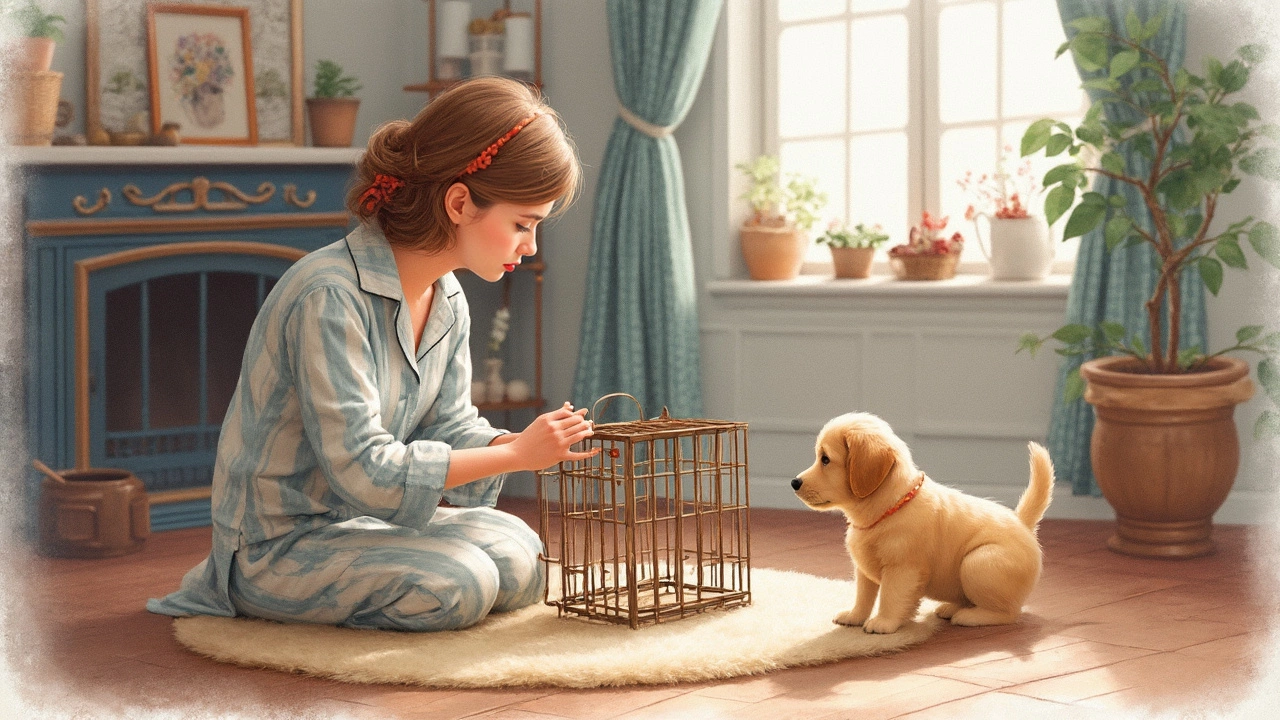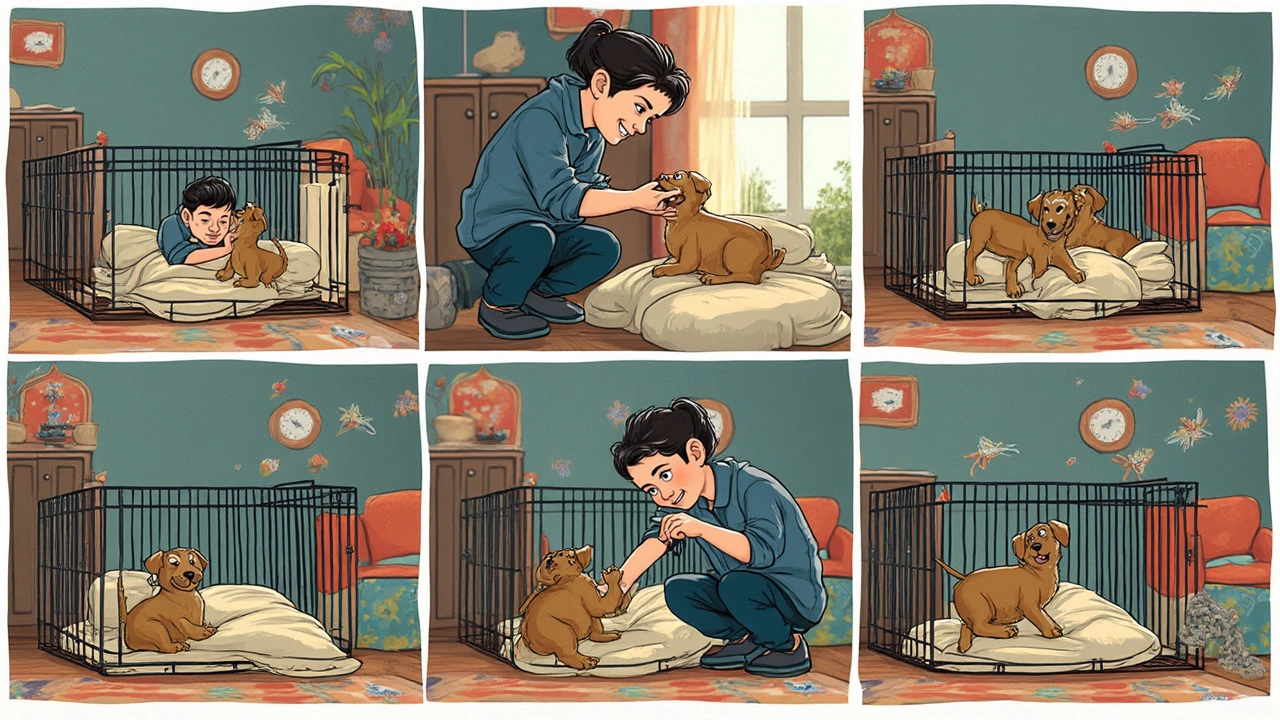Thinking about putting a pee pad in your puppy's crate at night? You’re definitely not alone. It's a common dilemma for new puppy parents who just want their little furballs to sleep soundly without turning their crate into a mess. But before you make a decision, let's dive into what this means for both your pup’s comfort and your long-term training goals.
Puppies have these tiny bladders that don’t hold much overnight, which might make you think a pee pad is the perfect solution. However, introducing a pee pad into the crate can sometimes send mixed signals, leading your puppy to think it's okay to potty where they sleep. That's not ideal, right? Understanding the balance is crucial.
- Understanding Puppy Bladders
- Pros and Cons of Using Pee Pads
- Alternatives to Pee Pads in Crates
- Training Tips for Nighttime
- Handling Accidents with Grace
Understanding Puppy Bladders
Puppy bladders are like tiny water balloons, often filled to capacity because puppies are all about exploration—and drinking lots of water. During the first few months, let's say up to about five months old, these little guys need more frequent potty breaks. This is crucial for their development and comfort.
On average, puppies can hold their bladder for about one hour per month of age. So, a two-month-old puppy can make it roughly two hours before needing a trip to the backyard. Nighttime stretches this a bit because they're resting, but it doesn’t mean they’ll always make it through the night without a bathroom break.
You might wonder if a pee pad is a quick fix here. Well, puppy bladder control is also about learning. When you pop a pee pad into their crate, it might train them that the crate is an okay spot to go potty. The flipside is that holding their bladder helps strengthen those muscles, kind of like when you potty-train a toddler.
Understanding their physical needs and setting expectations for yourself can help you prepare for nighttime with a little less stress. And remember, patience is key with these adorable, furry friends!
Pros and Cons of Using Pee Pads
Alright, so you're on the fence about whether to use a pee pad in your puppy's crate at night. It's a legit concern. Let's break it down with some pros and cons so you can make the best choice for both you and your furry friend.
Pros:
- Convenience: Having a pee pad in the crate can be a quick fix to avoid having to clean up accidents, especially during those early weeks when your pup literally can't hold it all night.
- Transition Tool: For puppies transitioning from freedom to crate training, pee pads can bridge the gap and reduce stress. It might help them feel they're not being punished if they can't hold their bladder through the night.
- Peace of Mind: Simply knowing there won't be a mess to scrub out at 3 AM can help you sleep a bit easier.
Cons:
- Mixed Signals: Putting a pee pad where they sleep can confuse your pup. They might think it's okay to do their business in their sleeping area, slowing crate training progress.
- Training Setback: Puppies generally avoid soiling their sleep areas. By allowing it, you could unintentionally set back long-term house training goals.
- Hygiene Issues: If the pad gets saturated overnight, it becomes less efficient and could end up making a bigger mess than if you had just let your puppy cry a bit for a bathroom break.
It's all about balance and what's going to work for your unique situation. If you decide to use a pee pad, just keep an eye on your puppy's development and adjust as needed so they don't become dependent on this temporary fix.

Alternatives to Pee Pads in Crates
When it comes to nighttime strategies for your puppy's crate, there are far more than just pee pads. Let’s explore some practical alternatives that might save you some extra cleaning and help your puppy learn the ropes without confusion.
First off, let’s talk about scheduling. Sometimes, the best solution doesn't involve the crate at all. Taking your puppy out for a bathroom break right before bed and first thing in the morning can make a huge difference. It's all about setting a routine. Puppies thrive on predictability, so try to stick to the same times each night and morning.
If you're worried about accidents, another great alternative is to set up a puppy playpen adjoining the crate. This gives your puppy space to rest but also a designated area to potty away from their bed if they really need to go. Just don’t forget to clean it up promptly to discourage repeat behavior in the same spot.
Training is key here. Using a crate divider can help in a big way. Puppies are naturally inclined not to soil their sleeping area. By reducing the size of the crate space with a divider, you can encourage them to hold on until it’s time for a real bathroom break outside.
Here’s another nifty tip: keep an ear out for your puppy during the night. You might hear them whimpering if they wake up and need to go. It’s exhausting work being a puppy parent, but getting up for those few extra minutes can prevent them from deciding the crate's a suitable spot for a toilet break.
Some folks also use absorbent bedding designed for pets. These can catch any accidents without teaching your pup that it's alright to relieve themselves in their bed. Just be sure to wash them regularly, to keep things fresh and clean for your little one.
With a bit of observation and a few adjustments to your routine, you can find an approach that makes nighttime a breeze without relying on pee pads in the crate.
Training Tips for Nighttime
Nights with a puppy don't have to be tough. With a little strategy, you can help your furry friend adjust to their new nighttime routine. First off, remember that consistency is key. Puppies thrive on routine, and a structured evening can make a world of difference.
Start by taking your pup outside for a bathroom break right before you settle down for the night. This helps set them up for a cleaner night in the crate. It might also ease your mind knowing they’ve had a chance to relieve themselves.
When it comes to the crate, keep it cozy and secure, but avoid adding a pee pad inside if you can. Instead, focus on comfort with a soft blanket. If accidents become a common issue, you may need to adjust how often you let them out at night. Puppies under three months might still need nighttime potty breaks. Setting an alarm for a quick trip outside can save both you and your puppy loads of frustration.
- Start with a pre-bedtime routine: Play to tire them out, followed by a calm period before crate time.
- Consistent feed and water schedule: Try to avoid giving food or water an hour or two before bedtime to minimize overnight accidents.
- Middle-of-the-night checks: If you hear any whining, take it as a cue for a quick bathroom trip rather than a chance for playtime.
- Praise success: Celebrate when they make it through the night without an accident, reinforcing their crate training progress.
By understanding your puppy’s needs and sticking to a steady schedule, you’ll manage the nighttime crate experience much more smoothly. And that means more restful nights for both of you!

Handling Accidents with Grace
Accidents happen, even with the best intentions and planning. If your puppy soils their crate overnight, it’s not the end of the world. What’s important is handling these mishaps calmly and effectively.
First, it’s key to remain patient. Puppies are still learning, and part of that learning curve involves making mistakes. Instead of feeling frustrated, use these accidents as teaching moments.
Here's how you can deal with an accident:
- Don’t scold your puppy harshly. They might not understand why they're being punished, which can lead to fear or anxiety around potty training. Instead, try to reinforce positive behavior when they get it right.
- Immediately clean the crate. Use an enzymatic cleaner specifically for pet messes. Regular household cleaners might mask the odor for us humans, but not for a dog’s sensitive nose!
- Check your schedule. It might mean your puppy needs more frequent bathroom breaks during the night. If possible, set up a schedule that lets your puppy go out a bit more often until their bladder grows stronger.
- Consider modifying their last meal or water intake time, being careful not to restrict their water access too much to keep them hydrated.
Finding the right routine can take time. Remember, consistency is key in puppy training. If accidents persist, it might be helpful to consult with a vet just to be sure there’s no underlying health issue.

